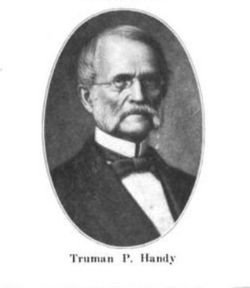The Not-So-Iron Horse, Pt. II
Duncan A. Virostko, Museum Assistant
“The initial founders were Aaron Barker, David H. Beardsley, Truman P. Handy, John W. Allen, Horace Perry, Lyman Kendall, and James S. Clark.”~ The Not-So-Iron Horse, Part I
The first installment of The Not-So-Iron Horse focused primarily on Ahaz Merchant, and his role as the builder of the Cleveland & Newburgh Railway, a combined horse and gravity worked railroad that was the first common carrier in Cleveland and traveled past Dunham Tavern starting in 1835.
But no man is an island, and Ahaz Merchant, although visionary, was not solely responsible for that line’s construction. In order to construct his new railroad, Ahaz needed financial backers, and there was no shortage of prominent Cleveland businessmen willing to invest in the new mode of transportation.
Many of these backers would not only support the Cleveland & Newburgh, but a number of other early attempts at building railroads in Cleveland, although it would take great expense and sixteen years until their efforts bore fruit and the city gained another railroad.
Chief amongst these were Truman P. Handy and John W Allen, both important Cleveland historical figures in their own rights, and deeply involved in early Cleveland railroad building efforts that would eventually lead to the founding of the first successful steam railroad in Cleveland: the Cleveland, Columbus & Cincinnati Railroad.
Truman P. Handy was an early banker, born in 1807 in New York, he moved to Cleveland in 1832 to serve as a cashier for the Commercial Bank of Lake Erie, Cleveland’s first bank. No doubt he was critical to financing the construction of the Cleveland & Newburgh, and would go on to play a similar role in organizing the Cleveland, Columbus & Cincinnati Railroad. He would serve as President of Merchants National Bank from 1862 onwards. He retired in 1892, and passed away shortly thereafter in 1898. Perhaps his most lasting contribution to Cleveland’s history however was his involvement in education. Handy helped to incorporate the Western Reserve Medical College and Case School of Engineering, and to establish the first short lived Cleveland college, Cleveland University (1851-54), of which Ahaz Merchant was also a trustee. He also served as the founder and President of the Cleveland Industrial School. Not content to merely contribute to the city’s education he was also involved in promotion of the arts, as president of the Cleveland Mozart Society, one of the city’s first choirs. His home along Euclid & East 12th St, built in 1842 and later owned by George B. Senter, would go on to become the site of the Union Club.
Truman P. Handy Home, Euclid & E. 12th St, Sterograph, ca. 1890.
John W. Allen was an even more important figure in early Cleveland history. Born in 1802 in Connecticut, Allen arrived in Cleveland in 1825 after graduating Harvard, likely passing by Rufus Dunham’s newly constructed house. He had come to study law under Judge Samuel Cowles, and joined the bar the same year, but his career lay not in the judicial but legislative and executive branches of government. He was a key figure in arguing for Congressional funding for a harbor in Cleveland in 1828, and from 1831 to 1835 was the President of the Board of Trustees for the Village of Cleveland. He was then elected that same year to the Ohio state senate, and subsequently to the House of Representatives. His Congressional term was brief, lasting only a year, but he would be reelected to the same seat in 1838. In 1841, Cleveland having grown from a village into a proper city, he was elected the fourth Mayor of Cleveland. Close friends with the famous senator, Henry Clay, Allen was primarily a Whig. Later, he would support the Republican Party when the earlier party split over the issue of slavery. It was this support which, late in life, granted him a position as the Cleveland Postmaster, to which he was appointed by President Grant in 1870 and reappointed in 1874. He would resign in 1874.
In addition to his illustrious political career, Allen was also a successful banker, being on the board of directors for the Commercial Bank of Lake Erie and later founding the Cleveland Insurance Co and the Society of Savings. He seems to have used his position at the Commercial Bank largely to fund railroad development: aside from the Cleveland & Newburgh, he also funded the Cleveland, Warren & Pittsburgh Railroad Company and the Ohio Railroad Company in 1836, both resounding failures that never built any track. He also helped fund the construction of the eventually successful Cleveland, Columbus & Cincinnati Railroad, starting in 1847.
Cleveland, Columbus, & Cincinnati Railroad entering Cleveland, Lithograph, ca. 1851. In lower left hand corner is the Columbus St. Bridge, pictured in Part I.
The first steam train in Cleveland ran on November 3rd, 1849. It was not an event attended with great ceremony, for it was merely a construction train: the Cleveland, Columbus, & Cincinnati Railroad would not be completed until 1851, and then only by arranging a trackage sharing agreement with the Xenia Railroad south of Columbus to Cincinnati.
The locomotive, CC&C No. 1, was one several 18 ton machines built locally by the Cuyahoga Steam Furnace company, and it drew several flatcars loaded with construction supplies. A surviving photo of a similar locomotive, CC&C No. 2 with a construction train near Berea, gives a good idea the kind of what this train would have looked like. The Cleveland Herald newspaper remarked of the event: “The whistle of the locomotive will be as familiar to the ears of the Clevelander as the sound of church bells.", and for the next 100 years they would be correct. The railroad age had reached Cleveland, and in a few short years the completion of the Cleveland & Buffalo RR in 1853 would help spur the creation of Cleveland’s first Union Depot, and spelled the end of Buffalo-Cleveland stagecoaches and Dunham Tavern.
Cleveland's 1st Union Depot, Lithograph, ca. 1853. Located at West 6th & West 9th St. Partially burned in 1864. It's replacement, built in 1866, lasted until 1953.
The story of the men behind both the Cleveland & Newburgh, and later Cleveland, Columbus, & Cincinnati Railroads holds many lessons for us in 2024. The most obvious, perhaps, is the dire need in the 21st Century to reestablish public transportation as a matter of public policy.
Only two passenger trains, Amtrak’s Lakeshore Limited & The Floridian presently serve Cleveland. The latter train was recently announced, and is a temporary combination of the Capitol Limited between Chicago and Washington, DC, and the Silver Star DC to Miami Florida, a two day journey by rail. It’s inaugural run will be November 10th, 2024.
We are fortunate in this regard: Columbus is presently the largest city in the United States without any rail service whatsoever. Traveling by rail between the three largest cities in the state, a journey easily accomplished by the traveler of 1853, is impossible today. The absurdity of this reality is compounded when you consider that in the present era we are striving to make travel more accessible, more ecologically friendly, and more economical: all benefits that rail travel provides.
On a more personal scale, it also remind us that perseverance, and not becoming discouraged by setbacks, is a key to success. Although the Cleveland & Newburgh was ultimately a failure, which cost it’s investors significant sums, they did not abandon the idea of a railroads connecting Cleveland to the wider world. Additionally, John Allen and Truman Handy’s contribution to Ahaz Merchants work shows that great things may be accomplished when person of different talents turn their energies towards a shared goal. Without Handy’s financial backing, or Allen’s money and political influence, Ahaz Merchant could not have used his surveying and engineering expertise to construct the Cleveland & Newburgh and usher in a new technological era for Cleveland.
Sources:
https://case.edu/ech/articles/a/allen-john-w
https://case.edu/ech/articles/h/handy-truman-p
https://case.edu/ech/articles/r/railroads
https://neo-trans.blog/2022/10/26/clevelands-first-railroad-is-history/
J. R. Quinn, “0-4-0 CC&C #2 at Berea, OH,” New York Central System Historical Society, accessed September 19, 2024, https://nycshs.omeka.net/items/show/135263.






